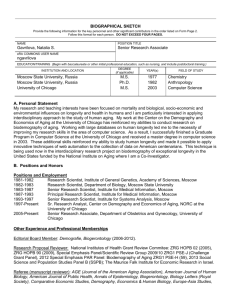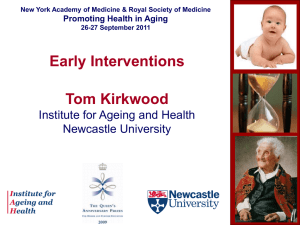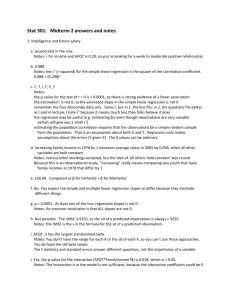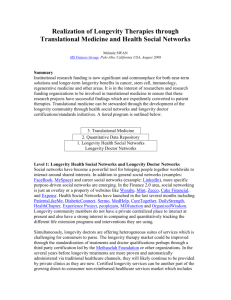PHS 398 (Rev. 5/01), Biographical Sketch Format Page
advertisement
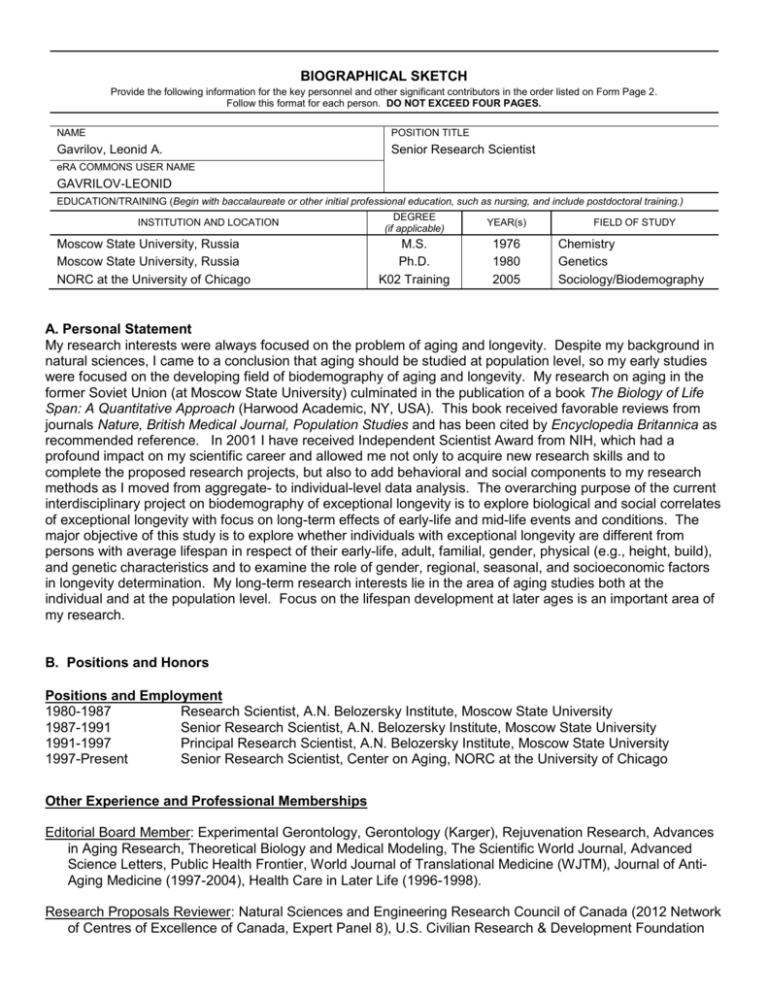
BIOGRAPHICAL SKETCH Provide the following information for the key personnel and other significant contributors in the order listed on Form Page 2. Follow this format for each person. DO NOT EXCEED FOUR PAGES. NAME POSITION TITLE Gavrilov, Leonid A. Senior Research Scientist eRA COMMONS USER NAME GAVRILOV-LEONID EDUCATION/TRAINING (Begin with baccalaureate or other initial professional education, such as nursing, and include postdoctoral training.) INSTITUTION AND LOCATION Moscow State University, Russia Moscow State University, Russia NORC at the University of Chicago DEGREE (if applicable) YEAR(s) M.S. Ph.D. K02 Training 1976 1980 2005 FIELD OF STUDY Chemistry Genetics Sociology/Biodemography A. Personal Statement My research interests were always focused on the problem of aging and longevity. Despite my background in natural sciences, I came to a conclusion that aging should be studied at population level, so my early studies were focused on the developing field of biodemography of aging and longevity. My research on aging in the former Soviet Union (at Moscow State University) culminated in the publication of a book The Biology of Life Span: A Quantitative Approach (Harwood Academic, NY, USA). This book received favorable reviews from journals Nature, British Medical Journal, Population Studies and has been cited by Encyclopedia Britannica as recommended reference. In 2001 I have received Independent Scientist Award from NIH, which had a profound impact on my scientific career and allowed me not only to acquire new research skills and to complete the proposed research projects, but also to add behavioral and social components to my research methods as I moved from aggregate- to individual-level data analysis. The overarching purpose of the current interdisciplinary project on biodemography of exceptional longevity is to explore biological and social correlates of exceptional longevity with focus on long-term effects of early-life and mid-life events and conditions. The major objective of this study is to explore whether individuals with exceptional longevity are different from persons with average lifespan in respect of their early-life, adult, familial, gender, physical (e.g., height, build), and genetic characteristics and to examine the role of gender, regional, seasonal, and socioeconomic factors in longevity determination. My long-term research interests lie in the area of aging studies both at the individual and at the population level. Focus on the lifespan development at later ages is an important area of my research. B. Positions and Honors Positions and Employment 1980-1987 Research Scientist, A.N. Belozersky Institute, Moscow State University 1987-1991 Senior Research Scientist, A.N. Belozersky Institute, Moscow State University 1991-1997 Principal Research Scientist, A.N. Belozersky Institute, Moscow State University 1997-Present Senior Research Scientist, Center on Aging, NORC at the University of Chicago Other Experience and Professional Memberships Editorial Board Member: Experimental Gerontology, Gerontology (Karger), Rejuvenation Research, Advances in Aging Research, Theoretical Biology and Medical Modeling, The Scientific World Journal, Advanced Science Letters, Public Health Frontier, World Journal of Translational Medicine (WJTM), Journal of AntiAging Medicine (1997-2004), Health Care in Later Life (1996-1998). Research Proposals Reviewer: Natural Sciences and Engineering Research Council of Canada (2012 Network of Centres of Excellence of Canada, Expert Panel 8), U.S. Civilian Research & Development Foundation (CRDF), Canadian Institutes of Health Research (CIHR), The Austrian Science Fund (FWF), Mathematics of Information Technology and Complex Systems Network of Centres of Excellence (MITACS-NCE), Canada. Referee: AGE (Journal of the American Aging Association), Ageing Research Reviews, Annals of Human Genetics, Biodemography and Social Biology, Biogerontology, Biology Letters (Royal Society), BioMed Central, Demography, Economics & Human Biology, European Journal of Population, Evolutionary Ecology Research (ISSN 1522-0613), Experimental Gerontology, FEBS Letters, Genus, Gerontology, International Journal of Biometeorology, International Journal of Epidemiology, Journal of Anti-Aging Medicine, Journal of Gerontology (Biological Sciences), Journal of Gerontology (Medical Sciences), Journal of the American Geriatrics Society, Journal of the American Statistical Association, Journal of the Royal Statistical Society, Series A (Statistics In Society), Journal of Theoretical Biology, Mathematical Biosciences, Mathematical Population Studies, Mechanisms of Ageing and Development, PLoS ONE, Population, Population and Development Review, Population Studies, Rejuvenation Research, Scandinavian Journal of Statistics, Social Biology, Social Science & Medicine, Sociological Methodology, TheScientificWorldJournal. Membership: Gerontological Society of America (fellow, member of the Executive Committee on Biological Sciences, member of the Task Force on Organizational Technology and Computers, 2007-2009), Population Association of America. Consultant for the NIA: NIH Professional Service Contract #263 SDN74858. Honors Moscow Society of Naturalists. Award for the best scientific research in natural science in 1986-1988 International Science Foundation Emergency Award for Russian Scientists of the Top Category (1993) U.S. Civilian Research and Development Foundation Proposal Development Program Award (1996) The European Union award (INTAS grant #93-1617) Featured in Wall Street Journal (March 2nd, 2012), The NIH Record (October 26, 2012), Science (6 June 1997, p.1503), The Scientist (May 13, 2002, p.20), Sunday Times London (June 15, 1997), The Guardian, UK (September 01, 2004), IEEE Spectrum (September 2004 issue, cover story) Cited by Who's Who in Medicine and Healthcare, 2002-2003, Who's Who in Science and Engineering 2003-3004, Who's Who in America 2002-2003. Cited by Encyclopedia Britannica as the author of recommended book "The Biology of Life Span." Invited author for Macmillan Encyclopedia of Aging (3 articles), Journal of Theoretical Biology special issue (2001, vol. 213), Springer-Verlag monograph "Sex and Longevity" (2000), Handbook of the Biology of Aging (2005), International Handbook of the Demography of Aging, Springer (2009), and Encyclopedia of the Life Course and Human Development, Gale Cengage (2008). Fellow of the Gerontological Society of America Selected high-profile presentations (last five years): Keynote: Demographic Analysis and Research International Workshop (Demographics-2013), June 2013, Mataro, Spain. Lecturer: Institut Universitaire de Medecine Sociale et Preventive, Universite de Lausanne (IUMSP), June 2013, Lausanne, Switzerland. Opening session lecture: International Conference "Determinants of Unusual and Differential Longevity," November 2012, Vienna, Austria. Keynote: Department of Molecular Biology retreat, October, 2012, Princeton University, Princeton, NJ. Keynote: Demographic Analysis and Research International Conference (Demographics 2012), June 2012, Chania, Greece. Keynote: International Congress "Our Common Future," November, 2010, Hannover-Essen, Germany. United Nations (UNPFA) Seminar "Contemporary Methods of Mortality Analysis," November, 2008, Bishkek, Kyrgyzstan. C. Selected Publications (in chronological order) 1. Gavrilov L. A., and N. S. Gavrilova. 1991. The Biology of Life Span: A Quantitative Approach, New York: Harwood Academic Publisher. 385p. 2. Gavrilov, L. A., and N. S. Gavrilova. 2001. The Reliability Theory of Aging and Longevity. Journal of Theoretical Biology, 213 (4): 527-545. PMID: 11742523 3. Gavrilov, L. A., and N. S. Gavrilova. 2001. Biodemographic Study of Familial Determinants of Human Longevity. Population: An English Selection, 13(1): 197-222. 4. Gavrilov, L. A., N. S. Gavrilova, S. J. Olshansky, and B. A. Carnes. 2002. Genealogical Data and Biodemography of Human Longevity. Social Biology, 49 (1-2):120-133. PMID: 14652915 5. Gavrilova NS, Gavrilov LA, Semyonova VG, Evdokushkina GN. 2004. Does Exceptional Human Longevity Come With High Cost of Infertility? Testing the Evolutionary Theories of Aging. Annals of the New York Academy of Sciences, 1019: 513-517. PMID: 15247077 6. Gavrilov, L. A., and N. S. Gavrilova. 2004. Early-Life Programming of Aging and Longevity: The Idea of High Initial Damage Load (the HIDL Hypothesis). Annals of the New York Academy of Sciences, 1019: 496-501. PMID: 15247073 7. Gavrilov LA, Gavrilova NS. 2006. Reliability theory of aging and longevity. In: Masoro E.J. & Austad S.N.. (eds.): Handbook of the Biology of Aging (Sixth Edition) (pp. 3-42). New York: Academic Press, Elsevier. 8. Gavrilova N.S., Gavrilov L.A. 2007. Search for predictors of exceptional human longevity: using computerized genealogies and internet resources for human longevity studies. North American Actuarial Journal, 11(1): 49-67. PMID: 22308064 9. Gavrilova N.S., Gavrilov L.A., Search for mechanisms of exceptional longevity. Rejuvenation Research, 2010, 13(2-3): 262-264. PMID: 20370503. PMCID: PMC2946054 10. Gavrilov L.A., Gavrilova N.S. Mortality measurement at advanced ages: A study of the Social Security Administration Death Master File. North American Actuarial Journal, 2011, 15(3): 432-447. PMID: 22308064. PMCID: PMC3269912 11. Gavrilov L.A., Gavrilova N.S. Season of birth and exceptional longevity: Comparative study of American centenarians, Their Siblings, and Spouses. Journal of Aging Research, 2011, Article ID 104616, 11 pages, doi:10.4061/2011/104616. PMID: 22187646. PMCID: PMC3236478 12. Gavrilova N.S., Gavrilov L.A., Severin, F.F. and Skulachev, V.P. Testing predictions of the programmed and stochastic theories of aging: Comparison of variation in age at death, menopause, and sexual maturation. Biochemistry (Moscow), 2012, 77(7), 754-760. PMID: 22817539 PMCID: PMC3428266 13. Gavrilov L.A., Gavrilova N.S. Biodemography of exceptional longevity: Early-life and mid-life predictors of human longevity. Biodemography and Social Biology, 2012, 58(1):14-39, DOI: 10.1080/19485565.2012.666121. PMID: 22582891 PMCID: PMC3354762 14. Gavrilov LA, Gavrilova NS. Determinants of exceptional human longevity: new ideas and findings. Vienna Yearbook of Population Research 2013;11:295-323. PMCID: PMC4165392. 15. Gavrilova NS, Gavrilov LA. Biodemography of old-age mortality in humans and rodents. J Gerontol A Biol Sci Med Sci 2014:Feb 17. [Epub ahead of print], doi: 0.1093/gerona/glu009. PMID: 24534516. PMC Journal - In Process. D. Research Support Ongoing Research R01 AG028620 (Gavrilov) 1/1/09 to 31/12/2013 (unfunded continuation to 12/31/2014) NIA Biodemography of Exceptional Longevity in the United States This project proposes to investigate why some people manage to survive to extreme old age (100+ years) and what are the biological and social correlates of exceptional longevity. The project will take advantage of the ongoing revolution in information technology for human longevity studies to examine the determinants of exceptional survival both on individual and population levels, using a rich variety of the U.S. data sources available through the Internet, including Social Security Administration datasets, Census data, family reconstitutions and validated genealogies, and military draft records. Role: Principal Investigator
